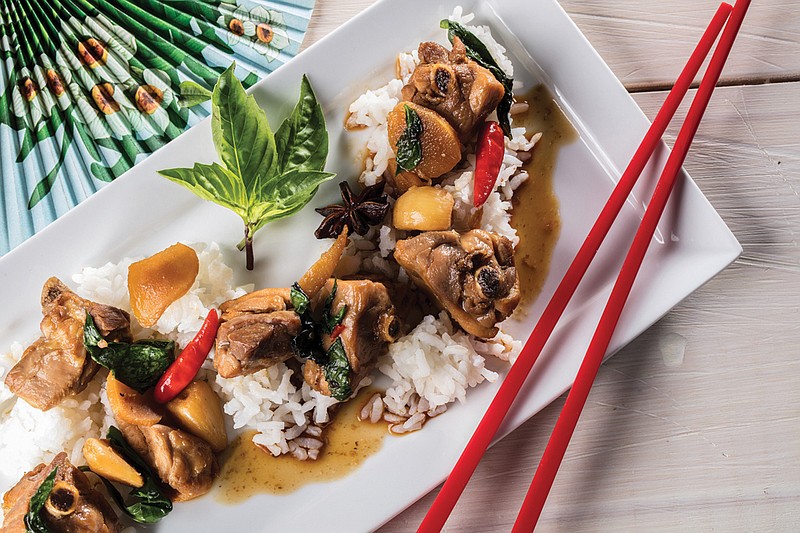When my editor asked if our team had any recipes to share for our month of "Craving: Chinese Food," I confidently raised my hand and blurted out, "Three-cup chicken."
After all, not only is the popular Taiwanese dish a comforting and flavorful meal that more people should know about, it would also require the absolute least amount of investigative work possible for me. Win-win!
The dish (san bei ji in Chinese) gets its name from the three equal portions of sesame oil, soy sauce and rice wine used to make the sauce. Add chicken and maybe a few other ingredients, and you're done. In that respect, it's a lot like pound cake, which traditionally calls for a pound each of flour, butter, eggs and sugar. All you need to know is right there in the title.
So imagine my surprise when I glanced through recipes for three-cup chicken and noticed that almost none maintained the three equal cups formula. In retrospect, it's easy to see why: Those proportions make for an exceedingly oily dish. Lessening the amount of sesame oil is the most common move, but it's definitely not the only one.
In fact, few versions agreed on the perfect proportion, meaning that my only path forward was to test various recipes and see which appealed to me. And just like that, my sweat-free assignment vanished before my eyes.
I started by dramatically cutting the amount of sesame oil, which helped with the heaviness. After experimenting with doubling the amount of rice wine, I went back to an equal proportion of soy sauce and rice wine. But what I quickly learned was that while the three ingredients that give the recipe its name are fundamental to the dish, they are by no means the only ones.
Ginger and garlic are essential, while some sugar helps balance the saltiness from the soy sauce. One surprising ingredient that kept popping up was Thai basil, which was always added at the end for an appealing pop of color and freshness. Grace Young in "The Breath of a Wok" had the bright idea of adding star anise, and I loved the aromatic notes it lent the chicken.
With the sauce sorted, I turned my attention to the chicken. Here, fortunately, there is a consensus. Every recipe called for using bone-in, dark-meat chicken cut into 2-inch pieces. I tried making it with white meat and even boneless dark meat, but the chicken always overcooked, and the sauce never tasted as developed as it should have.
This does require one to split bone-in chicken, a task that's relatively easy with a meat cleaver, though slightly harder with a regular kitchen knife. If you're particularly concerned, some dedicated butcher shops will do the work for you. It's worth the effort. The nuggets of chicken come out juicy and coated in the umami-packed and intricately flavored sauce. And while it took me far more effort to nail an adequate recipe than I'd imagined, the end result can be whipped up in about 30 minutes.
___
THREE-CUP CHICKEN
Prep: 10 minutes
Cook: 20 minutes
Makes: 4 servings
You can use boneless chicken thighs, if you want to avoid chopping through the bones, but the flavor will not be as deep.
2 pounds bone-in, skin-on chicken thighs and legs
1/4 cup sesame oil
10 whole peeled garlic cloves
1 piece (3 inches long) ginger, sliced into coins
2 dried red chiles
3/4 cup rice wine
3/4 cup soy sauce
3 whole star anise
1 1/2 tablespoons sugar
1 large handful fresh Thai basil leaves
Steamed white rice
1. Using a meat cleaver or a heavy kitchen knife, carefully cut through the bones of the chicken to make 2-inch wide pieces. Set aside.
2. Heat sesame oil over medium-high heat in a wok or large saute pan. Add garlic and ginger; cook until fragrant, about 30 seconds. Add chiles and chicken pieces. Stir-fry until chicken is lightly browned, 2 to 3 minutes.
3. Pour in the rice wine, soy sauce and star anise. Bring to a boil over high heat, then reduce heat to maintain a gentle simmer. Cook, uncovered, until chicken is completely cooked and tender, stirring occasionally, about 15 minutes.
4. Turn off the heat; stir in sugar and basil. Serve with white rice.
Nutrition information per serving: 445 calories, 23 g fat, 4 g saturated fat, 142 mg cholesterol, 15 g carbohydrates, 6 g sugar, 33 g protein, 3,135 mg sodium, 2 g fiber

